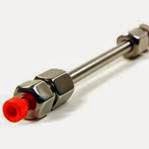The five major HPLC components and their functions
In a previous post entitled “What is Liquid Chromatography? What is HPLC (High Performance Liquid Chromatography)” the LC and the HPLC analytical techniques were introduced and the main advantages and disadvantages were explained.
The five major HPLC components and their functions are going to be presented in this post:
The Pump:
The role of the pump is to propel (force) a liquid (the mobile phase) through the chromatograph at a specific flow rate, expressed in ml/min. Normal flow rates in HPLC are 1-2 ml/min and typical pumps can reach pressures in the range of 2000 – 9000 psi but in applications covered under UHPLC mode operating pressure can be as high as 15000-18000 psi. The normal flow rate stability must be < 1%.

An ideal pump should have the following characteristics:
- Solvent compatibility and resistance to corrosion
- Constant flow delivery independent of back pressure
- Low dead volume for minimum problems on solvent changeover
The main types of pumps used in HPLC (or in LC) are the following:
- Constant Pressure Pumps : Provide consistent continuous flow rate through the column with the use of pressure from a gas cylinder.
- Constant Flow Pumps: a) Reciprocating Piston pumps deliver solvents through reciprocating motion of a piston in a hydraulic chamber. The main drawback of a reciprocating pump is that it produces a pulsing flow. With a flow-sensitive detector, such as micro-adsorption detector, a pulse damping system must be used and detector sensitivity is reduced. b) Syringe type pumps are suitable for small bore columns. Constant flow rate is delivered to column by a motorized screw arrangement.
The pump should be inert to solvents, buffer salts and solutes. They are made of stainless steel, titanium and resistant minerals.
There are two types of pump operation:
- Isocratic pump - delivers constant mobile phase composition
- Gradient pump – delivers variable mobile phase composition
The Injector:
The sample should be introduced as a plug, without disturbing the column packing. The injector serves to introduce the liquid sample into the flow stream of the mobile phase. Typical sample volumes are 5-20 μL. The injector must be able to withstand the high pressure of the mobile phase. A precolumn, a small removable section of tubing containing the same packing material as the column, can be used ahead of the analytical column to protect the latter from contamination. The precolumn also acts as a buffer to prevent channeling of the packing during injection.
The Column:
The column is considered the heart of the chromatograph. The success or failure of a particular analysis depends on the choice of column. The column’s stationary phase separates the sample components using various physical and chemical parameters.
There are four types of columns used in HPLC:
- High performance analytical columns [internal diameter (i.d.) 1.0-4.6 mm; lengths 15 –250 mm] - used mainly for qualitative and quantitative analysis
- Preparative columns (i.d. > 4.6 mm; lengths 50 –250 mm) – used mainly for preparative work
- Capillary columns (i.d. 0.1 -1.0 mm; various lengths)
- Nano columns (i.d. < 0.1 mm)

The tubing used for the construction of columns can be:
- Glass – mostly for biomolecules
- Stainless steel – the most popular; can withstand high pressures
- PEEK polymer – chemically inert to most solvents and biocompatible
Columns are packed with small diameter porous particles. Usually the size of the porous materials used are 1,6 – 5 μm. The column packings used in liquid/solid chromatography (LC, HPLC) are silica gel, charcoal and alumina. Most users purchase pre-packed columns to use in their liquid chromatographs. These porous particles in the column usually have a chemically bonded phase on their surface which interacts with the sample components to separate them from one another – for example, C18 is a popular bonded phase. The process of retention of the sample components is determined by the choice of column packing and the selection of the mobile phase to push the analytes through the packed column.
The Detector:
The Gradient Device:
What is reversed phase liquid chromatography (LC) / HPLC?
Normal phase liquid chromatography (LC) / HPLC?
Which are the main liquid chromatography separation modes? / Liquid-Liquid Chromatography (LLC)
Selection of the Liquid Chromatographic (LC) / HPLC Separation Mode
Troubleshooting HPLC / Liquid Chromatography Systems – Peak Tailing
- Nina Hadden et al., “Basic Liquid Chromatography”, Varian Aerograph, 1971
- C.A. Dorschel, J.L. Ekmanis, J.E. Oberholtzer et al. “LC Detectors” Anal. Chem., 61, 951A–968A, 1989
- C. F. Simpson, “Techniques in Liquid Chromatography” Wiley-Hayden: Chichester, England, 1982
- L.R. Snyder, J. L Glajch, J. J. Kirkland, “Practical HPLC Method Development”, Wiley-Interscience: New York, 1988.
- V.R. Meyer, “Practical High – Performance Liquid Chromatography”, Wiley, 2010
- M. McMaster, “LC/MS A Practical User’s Guide”, Wiley-Interscience, 2005
Your blog content are realy good and we supply HPLC Columns online.
ReplyDeleteVery useful for me
ReplyDeleteThank you.
ReplyDeleteI like that
ReplyDeleteThanks 😊
ReplyDelete